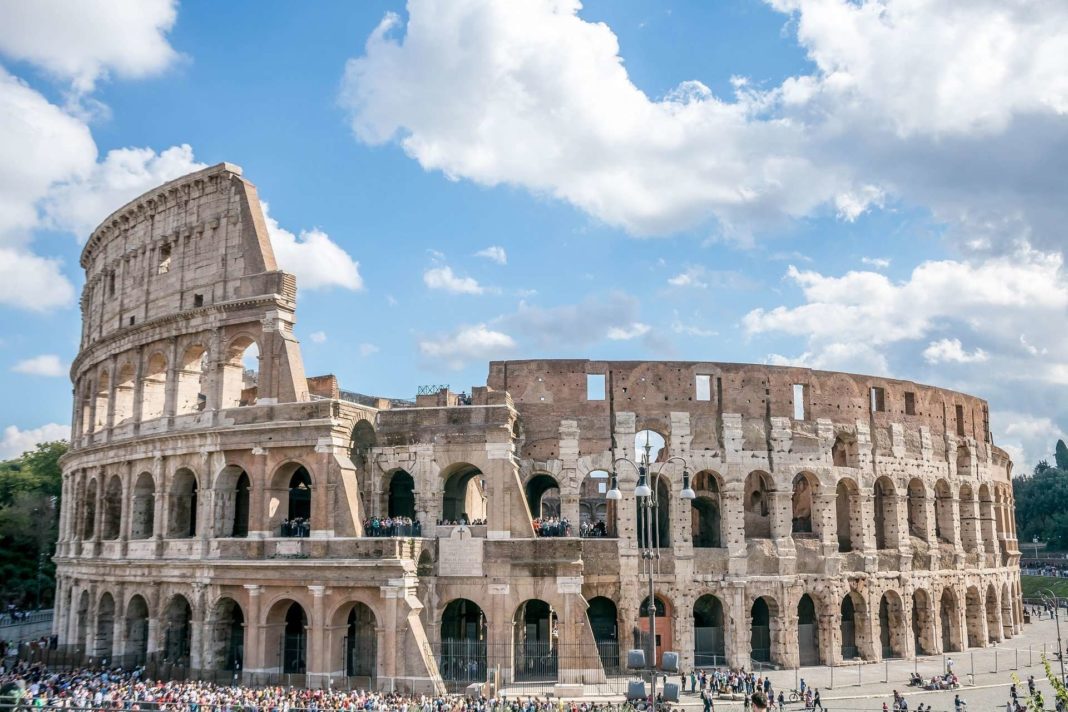Ah, Rome – the Eternal City. With its rich history, stunning architecture, and delicious cuisine, there’s no shortage of things to do and see in this vibrant destination. Whether you’re a first-time visitor or a seasoned traveler, Rome offers a plethora of activities and experiences that are sure to captivate and delight. From exploring ancient ruins and wandering through charming neighborhoods to indulging in gelato and sipping on espresso, Rome is a city that truly has something for everyone. So grab your map, lace up your walking shoes, and get ready for an unforgettable adventure in one of the world’s most beloved cities. Here are just a few of the many things to do in Rome that will leave you wanting more.
1. The Colosseum
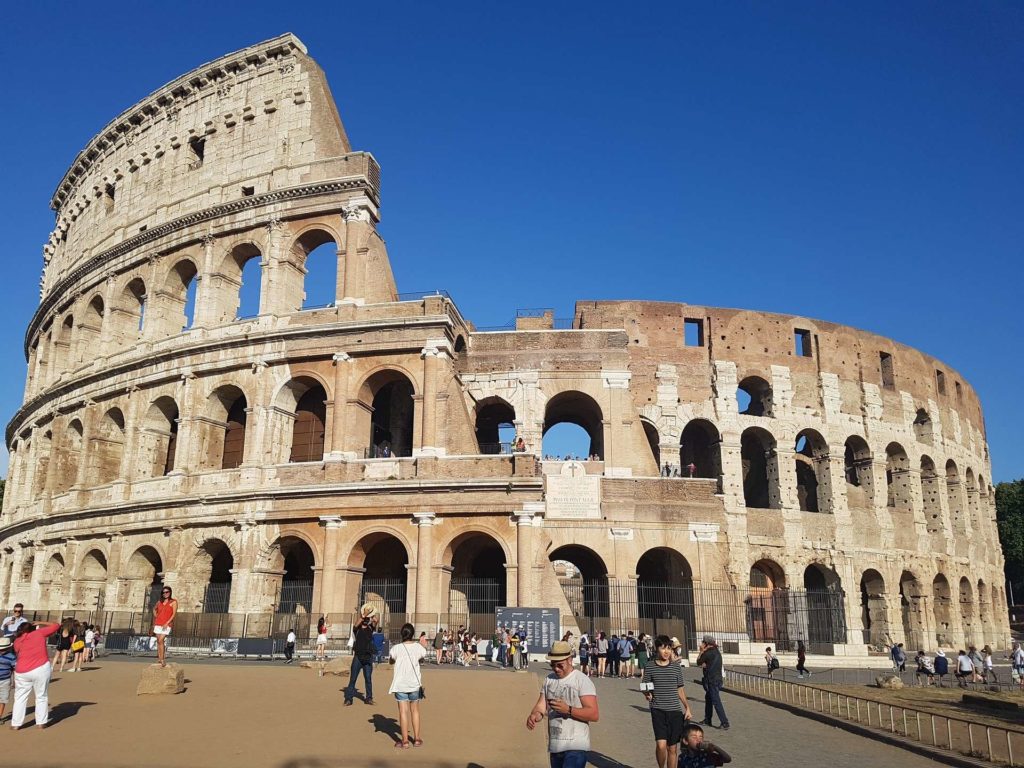
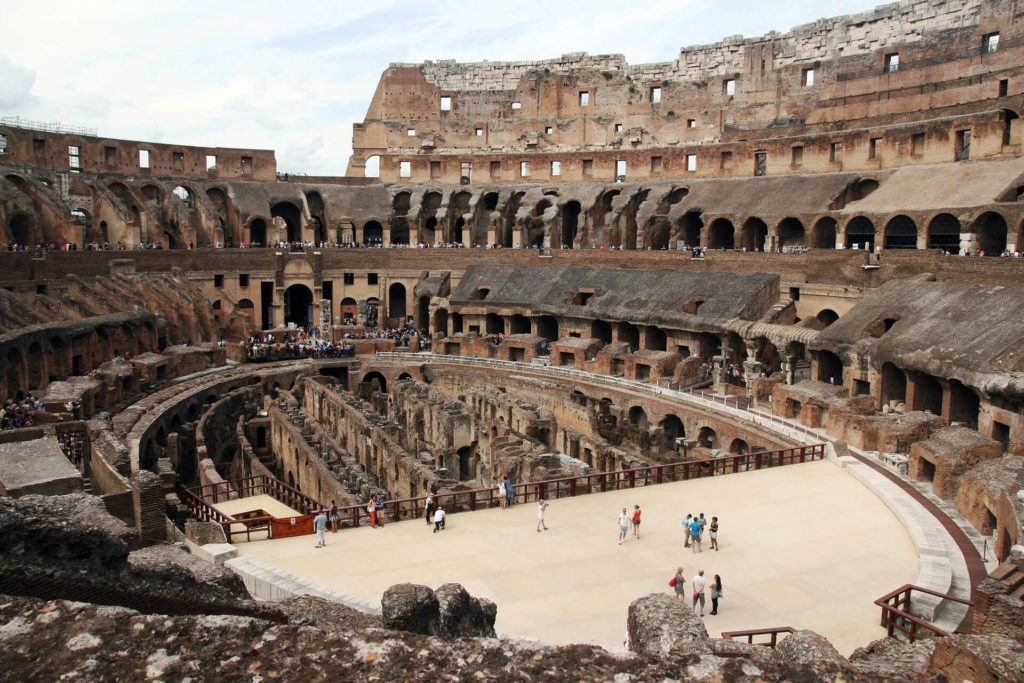
The Colosseum, also known as the Flavian Amphitheatre, is an ancient oval-shaped amphitheater located in the center of Rome, Italy. It is considered one of the greatest examples of Roman architecture and engineering and is an iconic symbol of Imperial Rome. The Colosseum was built between AD 70 and AD 80 under the rule of the Flavian emperors Vespasian and Titus.
The amphitheater is an impressive structure, measuring about 189 meters (615 ft) long, 156 meters (510 ft) wide, and 50 meters (164 ft) high. It could accommodate around 50,000 spectators, who would attend various public events such as gladiatorial contests, animal hunts, battle reenactments, and theatrical performances. The Colosseum also featured a retractable awning system, called the velarium, which provided shade for spectators during hot days.
Constructed primarily of travertine limestone, tuff (a type of volcanic rock), and concrete, the Colosseum has been partially ruined over time due to natural disasters, fires, and stone-robbing. Despite this, it remains one of the most popular tourist attractions in Rome and is an enduring symbol of the Roman Empire.
In 1980, the Colosseum was designated as a UNESCO World Heritage Site, and it is also listed as one of the New7Wonders of the World. Today, the monument serves as a powerful reminder of the ancient world and its rich history.
| 🤩 Tours & Deals | Check here |
| 🏨 Accommodation | Booking.com |
2. Arch of Constantine
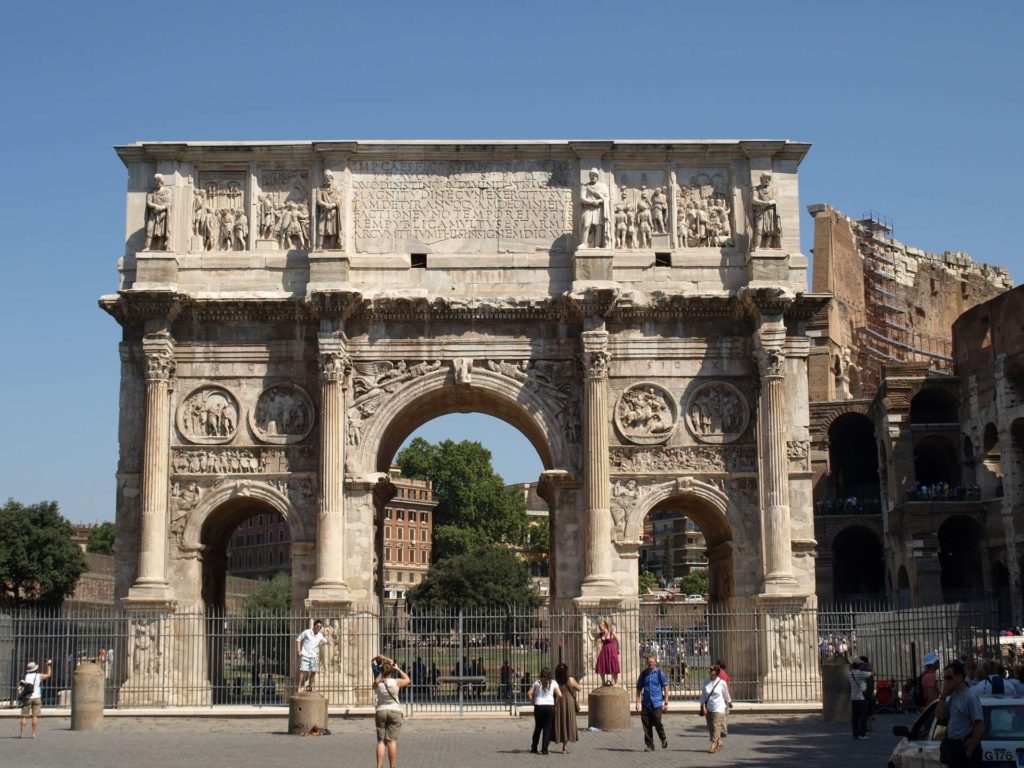
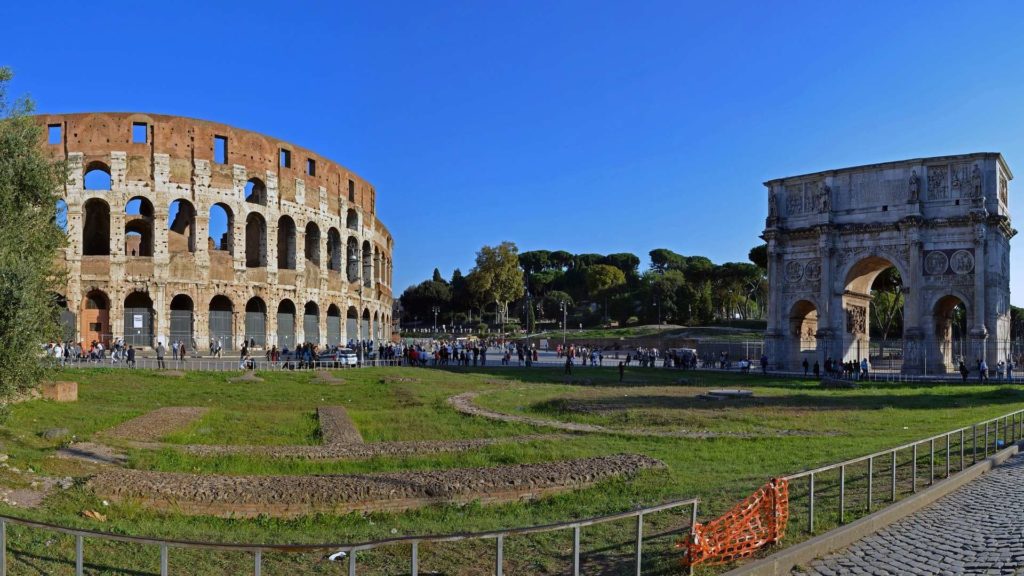
The Arch of Constantine is a triumphal arch located in Rome, Italy, near the Colosseum. It was erected to commemorate the victory of Roman Emperor Constantine the Great over his rival Maxentius at the Battle of Milvian Bridge in 312 AD. This battle is notable for being the turning point in Constantine’s conversion to Christianity, as he attributed his victory to the Christian God.
The Arch of Constantine stands approximately 21 meters (69 feet) high, 25.9 meters (85 feet) wide, and 7.4 meters (24 feet) deep. It is the largest and best-preserved of the remaining Roman triumphal arches. The arch consists of three main archways, with the central archway being the largest and the two smaller archways on each side.
The arch is richly decorated with sculptures and reliefs, many of which were taken from earlier monuments and repurposed to adorn the structure. These sculptures include depictions of victories, battles, and scenes from Constantine’s life. The use of spolia (reused materials) is a significant aspect of the Arch of Constantine, as it reflects a shift in artistic styles and priorities during the Late Roman Empire.
In addition to its historical and architectural significance, the Arch of Constantine also symbolizes the spread of Christianity within the Roman Empire. It marks the beginning of the Christianization of the empire and the eventual decline of paganism, as Constantine’s conversion to Christianity led to the Edict of Milan in 313 AD, which granted religious freedom to all citizens of the Roman Empire, including Christians.
3. Vatican City
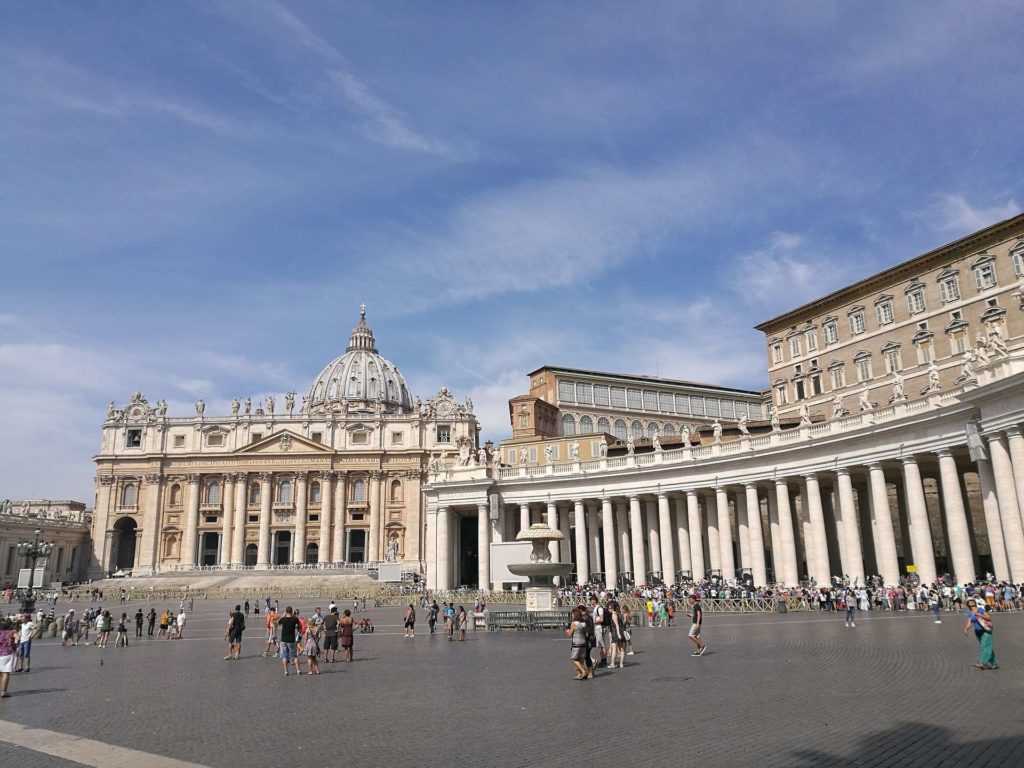

Vatican City, also known as the Vatican City State, is an independent city-state enclaved within Rome, Italy. It is the smallest sovereign state in the world, both in terms of area and population, covering approximately 44 hectares (110 acres) and having a population of about 800 people. Despite its small size, Vatican City holds significant religious, cultural, and political influence, primarily due to its status as the spiritual and administrative center of the Roman Catholic Church.
Vatican City was established as an independent state in 1929 through the Lateran Treaty, which was signed by Italy and the Holy See (the central governing body of the Catholic Church). This treaty resolved long-standing disputes between the Italian government and the Papacy over the latter’s temporal authority.
The Pope, who is the Bishop of Rome and the leader of the worldwide Catholic Church, serves as the head of state of Vatican City. The government of the city-state is composed of the Roman Curia, which includes various congregations, councils, and offices that assist the Pope in the governance of the Church.
Vatican City is home to several iconic cultural and religious sites, including:
- St. Peter’s Basilica: This famous church is one of the largest and most significant Christian sites in the world. It is built on the site where St. Peter, the first Pope and one of Jesus’ apostles, is believed to be buried.
- The Vatican Museums: These museums contain a vast collection of art and historical artifacts acquired by the Catholic Church over the centuries. The collection includes works by renowned artists such as Michelangelo, Raphael, and Leonardo da Vinci.
- The Sistine Chapel: Famous for its stunning frescoes painted by Michelangelo, the Sistine Chapel serves as the Pope’s private chapel and is also the site of the Papal Conclave, where the College of Cardinals convenes to elect a new Pope.
- The Vatican Library: This library houses one of the most significant collections of historical texts, manuscripts, and documents in the world, making it an essential resource for scholars and researchers.
Vatican City is also a UNESCO World Heritage Site, recognized for its cultural and historical significance. The city-state is a popular destination for tourists and pilgrims, attracting millions of visitors each year.
4. Piazza del Campidoglio (Capitol Square)
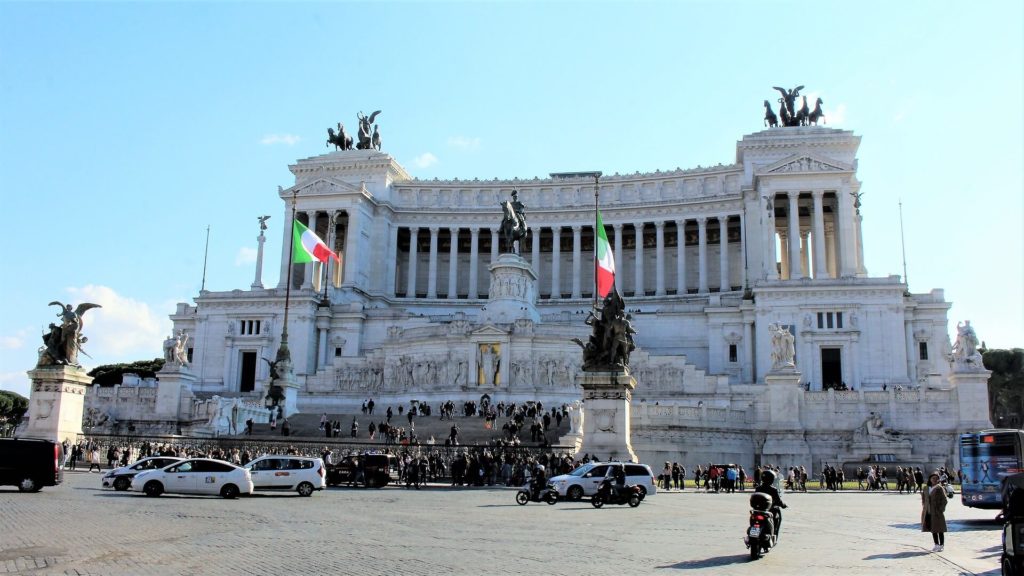 Piazza Venezia is a central square in Rome, Italy, located at the heart of the city where several important streets converge, including Via dei Fori Imperiali, Via del Corso, and Via del Plebiscito. The square is characterized by its bustling atmosphere and its mix of architectural styles, which represent various periods in Rome’s history.
Piazza Venezia is a central square in Rome, Italy, located at the heart of the city where several important streets converge, including Via dei Fori Imperiali, Via del Corso, and Via del Plebiscito. The square is characterized by its bustling atmosphere and its mix of architectural styles, which represent various periods in Rome’s history.
One of the most prominent buildings in Piazza Venezia is the Palazzo Venezia, a former papal residence and embassy of the Republic of Venice that dates back to the 15th century. The palace now houses the Museo Nazionale del Palazzo Venezia, which features a collection of art, decorative objects, and historical artifacts, including sculptures, ceramics, and paintings.
Another significant structure in the square is the Vittoriano, also known as the Altare della Patria (Altar of the Fatherland) or the Monument to Victor Emmanuel II. This grandiose monument was built in the early 20th century to honor Victor Emmanuel II, the first king of a unified Italy. The monument features a massive equestrian statue of the king, a large stairway, colonnades, and various sculptures and reliefs that celebrate Italy’s unification and independence.
The Vittoriano also houses the Tomb of the Unknown Soldier and an eternal flame, which commemorate the Italian soldiers who died during World War I. Visitors can take an elevator to the terrace of the monument, which offers panoramic views of the city.
In addition to these landmarks, Piazza Venezia is surrounded by various other important buildings, such as the Palazzo delle Assicurazioni Generali, the Palazzo Bonaparte, and the Church of San Marco Evangelista al Campidoglio.
Piazza Venezia is not only an important transportation hub but also a significant cultural and historical destination in Rome. The square’s unique blend of architectural styles, its lively atmosphere, and its proximity to other notable attractions, such as the Roman Forum and the Colosseum, make it a popular starting point for exploring the city.
5. The Pantheon
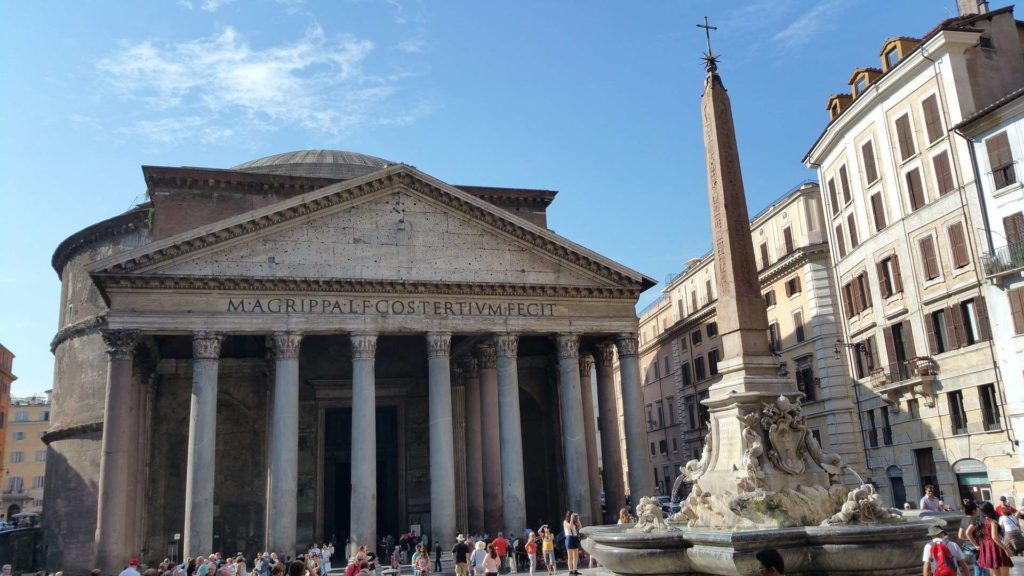
The Pantheon is a former Roman temple that now serves as a Catholic church, located in Rome, Italy. It is one of the best-preserved ancient Roman buildings and is renowned for its architectural and engineering marvels. The Pantheon was originally commissioned by Marcus Agrippa during the reign of Emperor Augustus (27 BC – 14 AD) and was later rebuilt by Emperor Hadrian in approximately 126 AD after it was destroyed by fire.
The name “Pantheon” is derived from the Greek words “pan” (all) and “theion” (divine), which together mean “of all the gods.” The temple was initially dedicated to all the Roman gods, but it was later consecrated as a Christian church in the 7th century, which has contributed to its preservation.
One of the most notable features of the Pantheon is its massive concrete dome, which remains the largest unreinforced concrete dome in the world. The dome has a diameter of 43.3 meters (142 feet) and was an impressive engineering feat for its time. The interior of the dome features a series of coffers (sunken panels) that reduce its weight and create an attractive geometric pattern.
At the apex of the dome, there is a large circular opening called the oculus, which measures 8.7 meters (28.7 feet) in diameter. The oculus serves as the only source of natural light for the interior of the Pantheon and creates a unique play of light and shadow throughout the day. When it rains, the water drains through the slightly sloped floor and exits through a drainage system.
The Pantheon’s façade features a portico with sixteen massive granite Corinthian columns, each measuring 11.8 meters (39 feet) high. The triangular pediment above the portico bears the original inscription of Marcus Agrippa, even though the building as it stands today was constructed during Hadrian’s reign.
Today, the Pantheon is a popular tourist attraction and an active church, known as the Basilica of St. Mary and the Martyrs (Santa Maria ad Martyres in Italian). It also serves as the burial site for several prominent Italians, including the Renaissance artist Raphael and the Italian kings Victor Emmanuel II and Umberto I.
6. Roman Forum
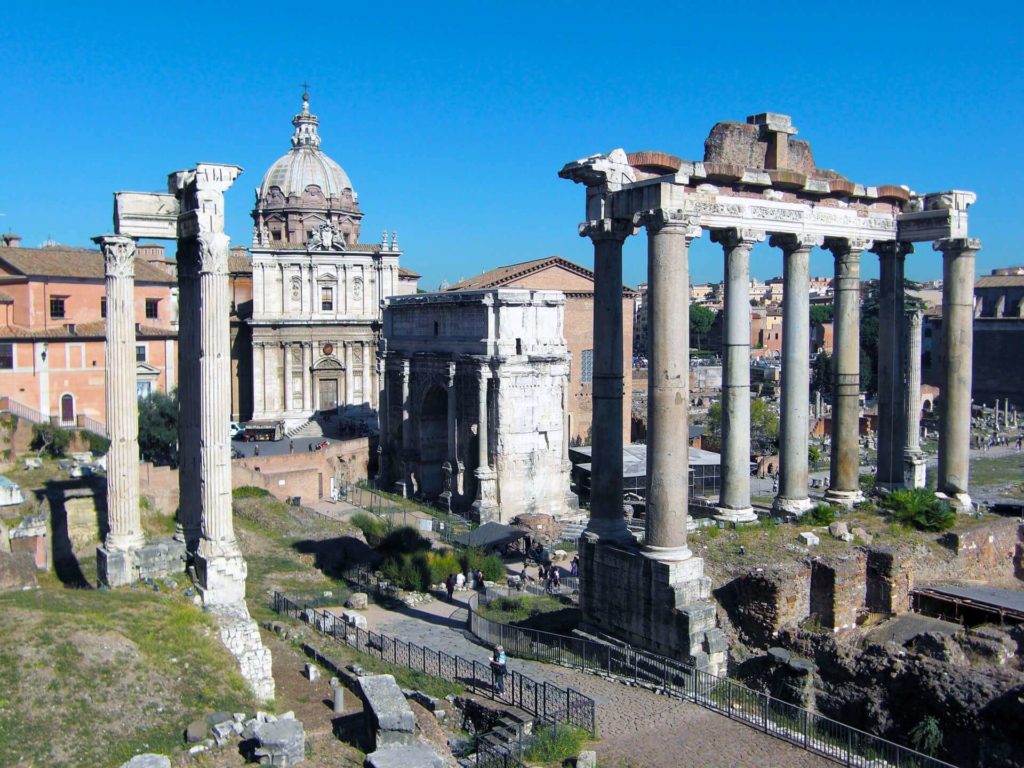
The Roman Forum, also known as Forum Romanum in Latin, is a rectangular plaza surrounded by the ruins of several important ancient government buildings in the heart of Rome, Italy. It was once the center of Roman public life, serving as a hub for politics, commerce, religion, and social activities. Over time, the Forum evolved from a simple marketplace to a complex and monumental city center that symbolized the power and glory of the Roman Empire.
Many significant structures were located in the Roman Forum, including temples, basilicas, arches, and monuments. Some of the most notable buildings and sites in the Forum include:
- The Temple of Saturn: This ancient temple was dedicated to the god Saturn and served as the official treasury of the Roman Republic and later the Empire.
- The Arch of Titus: This triumphal arch was constructed in 81 AD to commemorate the victories of Emperor Titus, particularly the Siege of Jerusalem in 70 AD.
- The Temple of Vesta: This small, circular temple was dedicated to the goddess Vesta, the guardian of the hearth and home. The temple housed the sacred fire of Rome, which was tended to by the Vestal Virgins.
- The Curia Julia: This building functioned as the meeting place of the Roman Senate, the governing body of the Roman Republic and later the Empire.
- The Basilica of Maxentius and Constantine: Also known as the Basilica Nova, this enormous building served as a public meeting hall and courthouse. It is one of the last monumental structures built in the Roman Forum.
- The Rostra: This speaker’s platform was a central location for political speeches, announcements, and debates.
Over the centuries, the Roman Forum fell into disrepair and was buried under layers of debris, as Rome faced invasions, looting, and a decline in political power. Excavations began in the 18th and 19th centuries, revealing the ruins that are visible today.
The Roman Forum is now a major tourist attraction and an essential archaeological site, offering valuable insights into the ancient Roman civilization. It is situated adjacent to other significant landmarks such as the Colosseum, the Palatine Hill, and the Capitoline Hill, forming a fascinating historical and cultural complex for visitors to explore.
7. Trevi Fountain
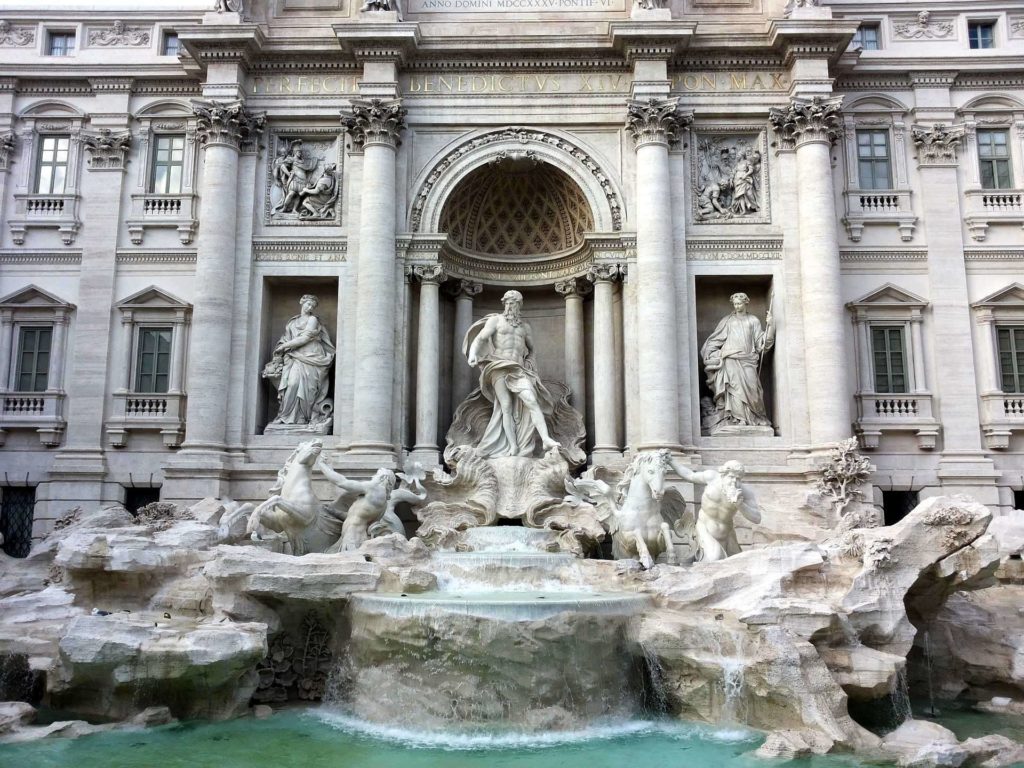
The Trevi Fountain, or Fontana di Trevi in Italian, is a famous and iconic Baroque-style fountain located in Rome, Italy. It is the largest and one of the most well-known fountains in the city, drawing numerous tourists every year. The fountain was designed by Italian architect Nicola Salvi and completed by Pietro Bracci in 1762.
The Trevi Fountain stands at an impressive 26.3 meters (86 feet) high and 49.15 meters (161 feet) wide, and it is built against the façade of the Palazzo Poli. The fountain features a central figure of Oceanus, the god of all water, standing on a chariot in the shape of a seashell, pulled by two sea horses and guided by two Tritons. The sculptures and reliefs on the fountain depict various mythological and allegorical themes related to water and its significance.
One of the most popular traditions associated with the Trevi Fountain is the coin toss. It is believed that if a visitor throws a coin over their left shoulder with their right hand into the fountain, they will ensure a return trip to Rome. The tradition is based on an ancient Roman custom of tossing coins into water sources to seek the favor of the gods. Each day, thousands of tourists participate in this ritual, and the coins collected are used to fund charitable projects in Rome.
The Trevi Fountain has appeared in various films and works of literature, making it a recognizable symbol of Rome’s romantic and artistic charm. In recent years, the fountain has undergone restoration works to preserve its beauty and structural integrity, ensuring that it remains a beloved attraction for generations to come.
8. Centro Storico & the Spanish Steps
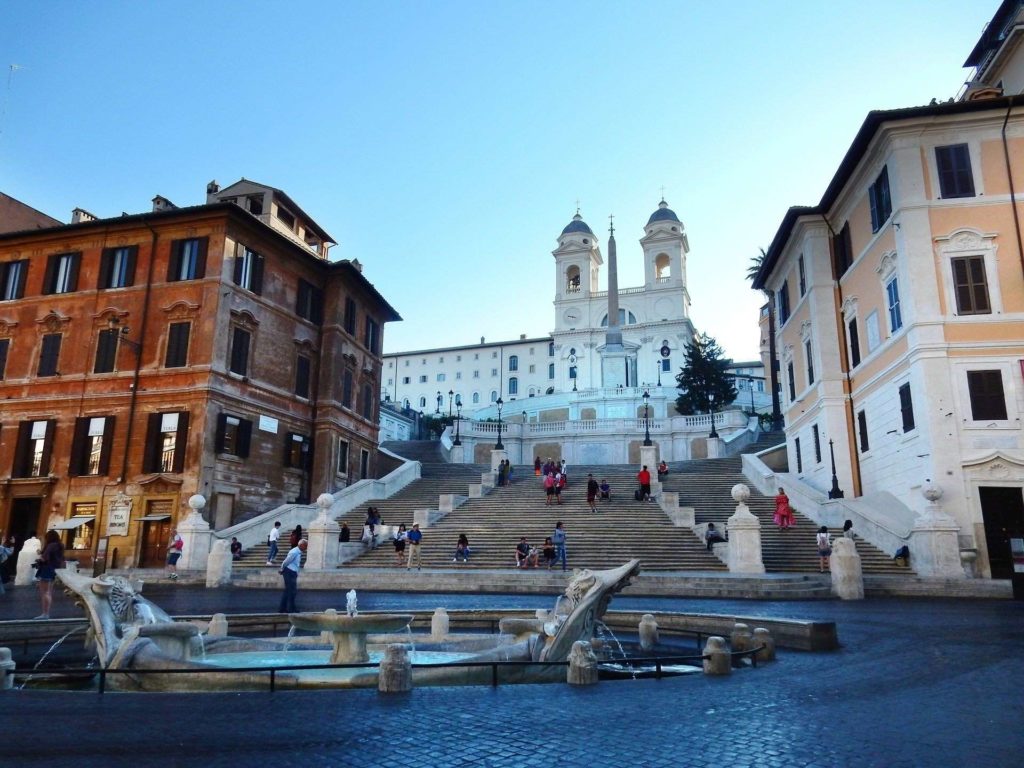
The Centro Storico, or Historic Center, of Rome is the area that encompasses the city’s most significant historical and cultural sites. This area is characterized by its narrow, winding cobblestone streets, beautiful squares (piazze), ancient ruins, and magnificent churches. The Centro Storico is a UNESCO World Heritage Site, recognized for its immense cultural, historical, and artistic value.
Within the Centro Storico, you will find many famous landmarks, including the Pantheon, the Roman Forum, the Colosseum, Piazza Navona, Campo de’ Fiori, and the Spanish Steps. The area is not only a popular tourist destination but also a vibrant part of Rome, where locals and visitors alike can experience the city’s rich history, art, and daily life.
The Spanish Steps, or Scalinata di Trinità dei Monti in Italian, is a monumental staircase located in Rome’s Centro Storico, connecting the Piazza di Spagna at the base with the Piazza Trinità dei Monti at the top. The staircase was designed by architects Francesco de Sanctis and Alessandro Specchi and completed in 1725. The Spanish Steps consist of 135 steps and were built to connect the Trinità dei Monti church, under the patronage of the French, with the Spanish Embassy located in the Piazza di Spagna, which is how the steps got their name.
The Spanish Steps have long been a popular gathering place for both locals and tourists. In the spring, the steps are adorned with beautiful azalea flowers, creating a colorful and picturesque setting. At the base of the steps, you’ll find the Barcaccia Fountain, a unique boat-shaped fountain designed by Pietro Bernini and his son, Gian Lorenzo Bernini.
The area surrounding the Spanish Steps is known for its upscale shops, cafes, and luxury hotels, making it an attractive destination for shopping, dining, and people-watching. The Spanish Steps have also been immortalized in literature and film, further contributing to their iconic status as a symbol of Rome’s charm and elegance.
9. Santa Maria Maggiore
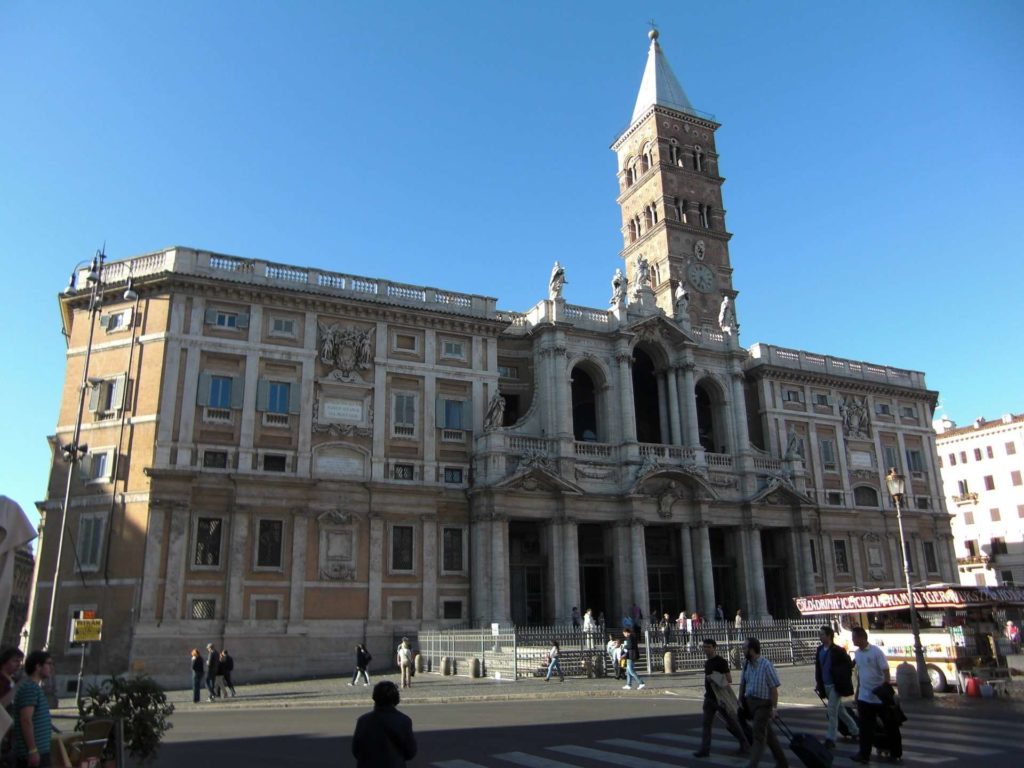
The Basilica di Santa Maria Maggiore, or Saint Mary Major, is one of the four major papal basilicas in Rome, Italy. It is also one of the oldest and most important churches dedicated to the Virgin Mary in Rome. The basilica is located on the Esquiline Hill and is easily recognized by its tall bell tower, which is the highest in Rome.
The basilica’s construction dates back to the 5th century under the reign of Pope Sixtus III (432-440 AD). The church has undergone several renovations and restorations throughout the centuries, with architectural elements from different periods, including the original early Christian design, as well as later Baroque and Neoclassical additions.
The interior of Santa Maria Maggiore is richly decorated with beautiful mosaics, marble, frescoes, and gilt stucco. The mosaics in the nave and triumphal arch are among the oldest and most significant in Rome, depicting scenes from the Old Testament and the life of Christ. The basilica also houses the Borghese Chapel, which contains the tomb of Pope Paul V and several members of the Borghese family.
One of the most famous relics in the basilica is the icon of the Virgin Mary known as the Salus Populi Romani, or “Protectress of the Roman People.” This ancient Byzantine icon, believed to date back to the 5th or 6th century, is associated with numerous miracles and has been venerated by various popes throughout history.
Santa Maria Maggiore is not only a major religious site but also a significant historical and artistic attraction in Rome. The basilica has been granted extraterritorial status as a property of the Holy See, and it remains under the jurisdiction of the Pope as the Bishop of Rome.
10. Piazza Navona
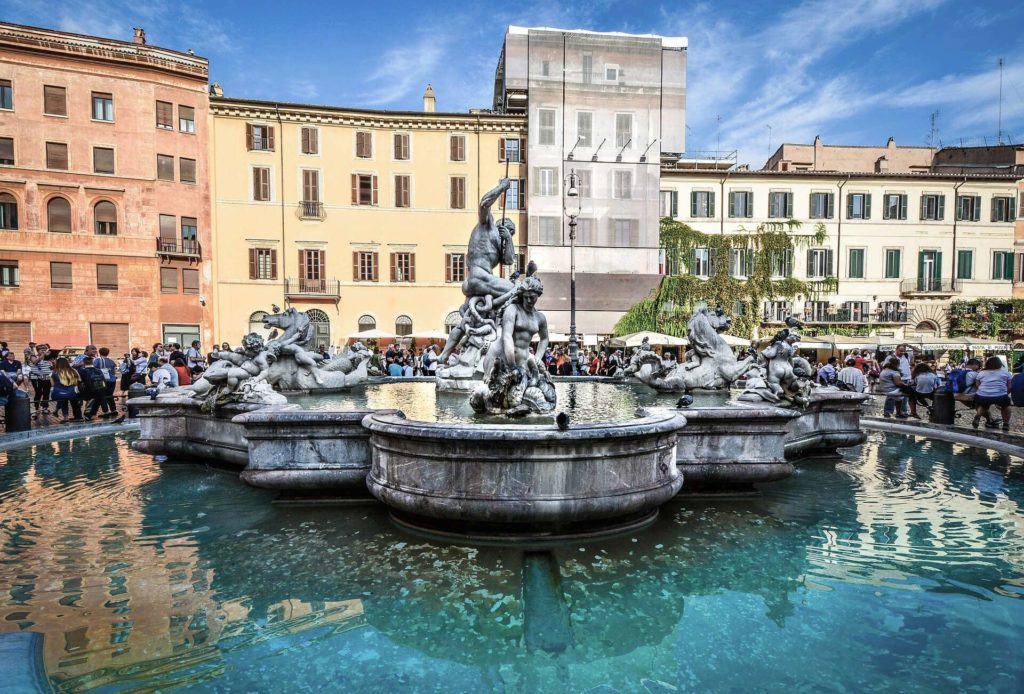
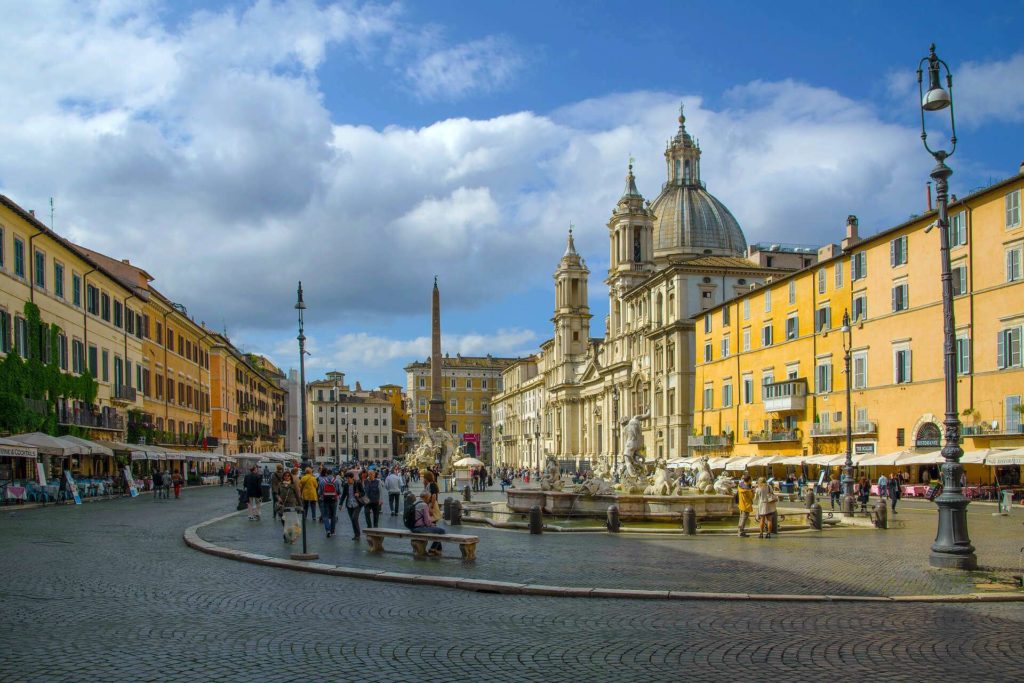
Piazza Navona is a famous public square located in the historic center of Rome, Italy. It is renowned for its beautiful Baroque architecture, lively atmosphere, and vibrant history. The square is an elongated rectangle in shape, following the layout of the ancient Stadium of Domitian, which was built in the 1st century AD for athletic competitions and other public events. The remains of the stadium can still be found beneath the modern square.
Piazza Navona is surrounded by elegant buildings, cafes, and restaurants and is a popular gathering place for both locals and tourists. The square is home to three magnificent fountains, which contribute to its charm and fame:
- Fontana dei Quattro Fiumi (Fountain of the Four Rivers): This fountain, located in the center of the square, was designed by the famous Baroque sculptor Gian Lorenzo Bernini in 1651. The fountain features four allegorical figures representing the great rivers of the four continents known at the time: the Nile (Africa), the Danube (Europe), the Ganges (Asia), and the Rio de la Plata (Americas). An Egyptian obelisk, originally from the Circus of Maxentius, stands at the center of the fountain.
- Fontana del Moro (Moor Fountain): Situated at the southern end of the square, this fountain was originally designed by Giacomo della Porta in 1575, and later, in 1653, Bernini added the central figure of a Moor wrestling with a dolphin.
- Fontana del Nettuno (Neptune Fountain): Also known as the Fountain of Neptune, this fountain is located at the northern end of the square. It was designed by Giacomo della Porta in 1574, and in the 19th century, the statues of Neptune and the Nereids were added by Antonio della Bitta and Gregorio Zappalà.
In addition to the fountains, Piazza Navona also features the Church of Sant’Agnese in Agone, designed by architects Francesco Borromini and Girolamo Rainaldi. The church is a beautiful example of Baroque architecture, and its concave façade complements the convex façade of Bernini’s Fountain of the Four Rivers.
Throughout the year, Piazza Navona hosts various events, including art exhibitions, street performances, and a vibrant Christmas market. The lively atmosphere and architectural splendor make Piazza Navona a must-see destination when visiting Rome.
11. Palatine Hill
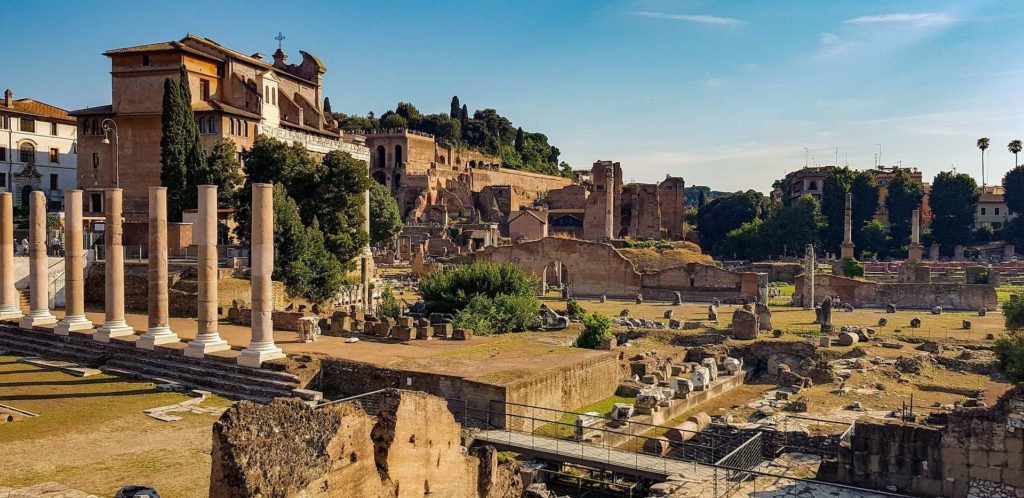
Palatine Hill, or Palatino in Italian, is one of the Seven Hills of Rome and holds a significant place in Roman mythology and history. It is located between the Roman Forum and the Circus Maximus and overlooks the Tiber River. According to Roman mythology, the Palatine Hill is where the she-wolf Lupa found the twin brothers Romulus and Remus, who were abandoned as infants. Romulus eventually founded Rome on the same hill in 753 BC.
The Palatine Hill was the location of choice for many affluent Romans, who built their palaces and luxurious homes here. The hill’s strategic position offered both a beautiful view of the city and a refuge from the busy urban life. The area was also considered sacred, with various temples and shrines dedicated to different gods and goddesses.
During the Roman Empire, the Palatine Hill became the site of the imperial residences, with emperors such as Augustus, Tiberius, and Domitian constructing their palaces here. The most famous palace is the Flavian Palace, also known as Domus Flavia, built during Emperor Domitian’s reign in the 1st century AD. The palace was a massive complex consisting of state apartments, private quarters, and a vast garden with fountains and porticoes.
Today, the Palatine Hill is an open-air museum and archaeological site where visitors can explore the ruins of the ancient buildings, palaces, and gardens. Some of the most notable sites on the hill include:
- The House of Augustus (Casa di Augusto): The residence of Rome’s first emperor, Augustus, which features well-preserved frescoes and decorations.
- The House of Livia (Casa di Livia): The residence of Emperor Augustus’s wife, Livia, with beautifully preserved frescoes.
- The Farnese Gardens (Orti Farnesiani): The first botanical garden in Europe, created during the Renaissance on the ruins of Emperor Tiberius’s palace.
Visiting the Palatine Hill offers a fascinating insight into the lives of ancient Rome’s most powerful figures and an opportunity to appreciate the grandeur of Roman architecture. A combined ticket for the Palatine Hill, Roman Forum, and the Colosseum allows visitors to explore these interconnected historical sites conveniently.
12. Villa Borghese Gallery and Gardens
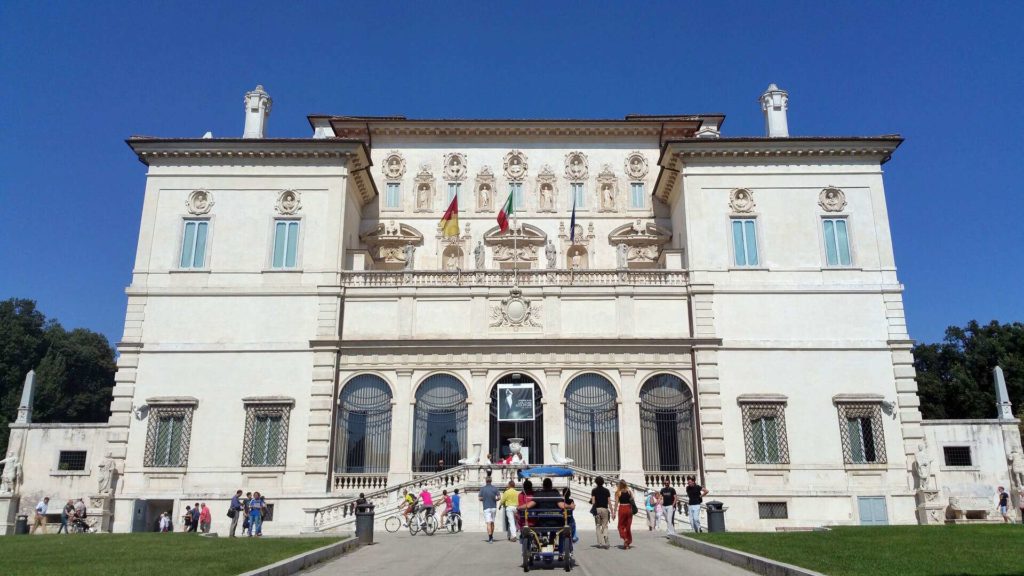
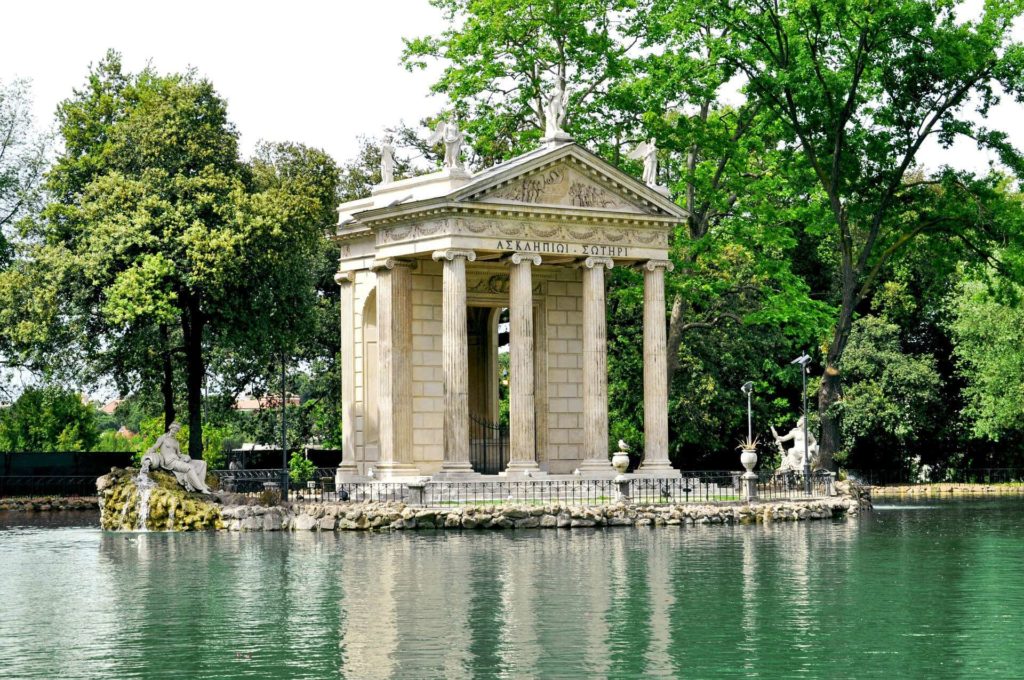
Villa Borghese is a large public park in Rome, Italy, featuring landscaped gardens, walking paths, fountains, and statues. The park spans approximately 80 hectares (198 acres) and was created in the early 17th century by the prominent Borghese family. The park was designed in the English garden style, with a combination of natural and formal elements. Villa Borghese was opened to the public in 1903, and it has since become a favorite recreational area for both locals and tourists.
Within the Villa Borghese park, the Galleria Borghese, or Borghese Gallery, is a notable art museum housed in the Villa Borghese Pinciana, which was originally built as a private villa for Cardinal Scipione Borghese, a nephew of Pope Paul V. The cardinal was an avid art collector, and he commissioned the villa to display his vast collection of sculptures, paintings, and antiquities.
The Galleria Borghese features works by many renowned artists, including Gian Lorenzo Bernini, Caravaggio, Titian, and Raphael. Some of the most famous pieces in the museum include:
- Bernini’s sculptures “Apollo and Daphne,” “David,” and “The Rape of Proserpina.”
- Caravaggio’s paintings “Boy with a Basket of Fruit,” “St. Jerome Writing,” and “David with the Head of Goliath.”
- Titian’s painting “Sacred and Profane Love.”
- Raphael’s painting “The Deposition.”
In addition to the art collection, the museum itself is a work of art, featuring frescoes, stuccos, and beautiful architectural details that reflect the opulence of the Baroque period.
Visitors should note that due to the popularity of the Galleria Borghese and limited capacity, it is highly recommended to book tickets in advance. The time slots for entry are strictly enforced to ensure a comfortable experience for all guests.
Villa Borghese and the Galleria Borghese offer a delightful combination of art, history, and nature, making it a must-visit destination when in Rome.
13. Castel Sant’Angelo National Museum
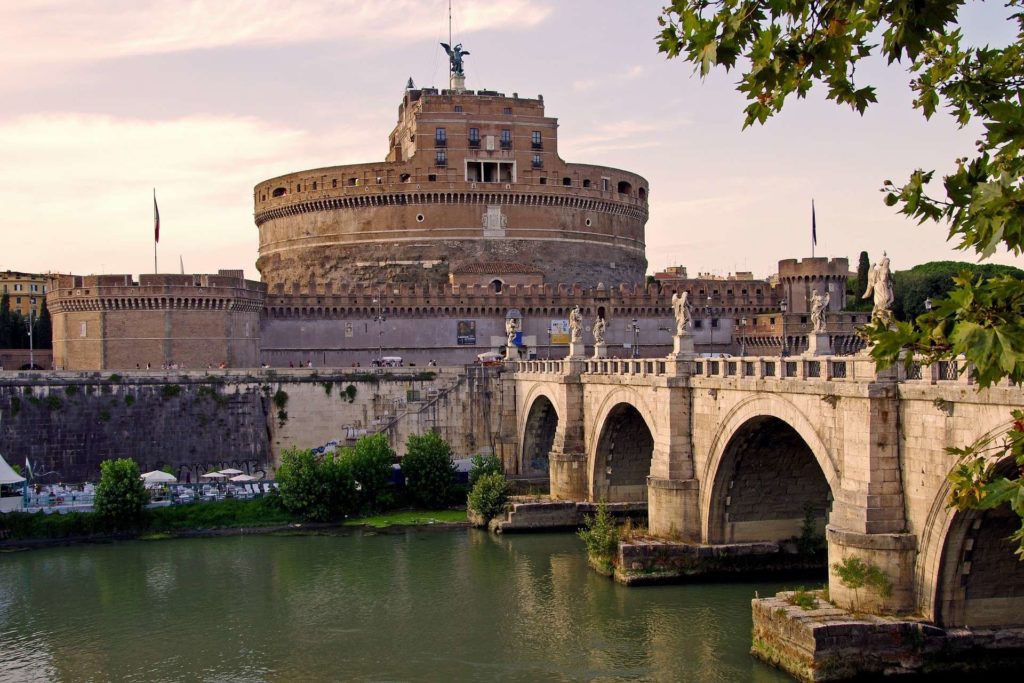
The Castel Sant’Angelo, also known as the Mausoleum of Hadrian, is a historic fortress and museum located along the Tiber River in Rome, Italy. The building was initially constructed as a mausoleum for Emperor Hadrian and his family in the 2nd century AD. Over time, the structure underwent various transformations, serving as a fortress, a papal residence, and a prison.
The Castel Sant’Angelo is characterized by its cylindrical shape and a large central tower, topped by a bronze statue of the archangel Michael. According to legend, in 590 AD, Archangel Michael appeared on top of the fortress, sheathing his sword as a sign that the plague that had struck Rome would soon end. This event led to the renaming of the building as Castel Sant’Angelo, or Castle of the Holy Angel.
Today, the Castel Sant’Angelo functions as the Museo Nazionale di Castel Sant’Angelo, or the Castel Sant’Angelo National Museum. The museum features a rich collection of art, artifacts, and historical objects, including ancient Roman sculptures, Renaissance paintings, and weapons used throughout history. Visitors can explore the various chambers, courtyards, and ramparts of the fortress, as well as the papal apartments with their beautifully frescoed rooms.
One of the unique features of the Castel Sant’Angelo is the Passetto di Borgo, an elevated passageway that connects the fortress to the Vatican City. This hidden corridor was used by popes in times of danger as an escape route to seek refuge in the fortified castle.
The Castel Sant’Angelo offers a fascinating glimpse into Rome’s layered history, from the Roman Empire to the Renaissance and beyond. The castle’s terrace also provides a stunning panoramic view of the city, making it a popular destination for tourists and history enthusiasts alike.
14. Baths of Caracalla
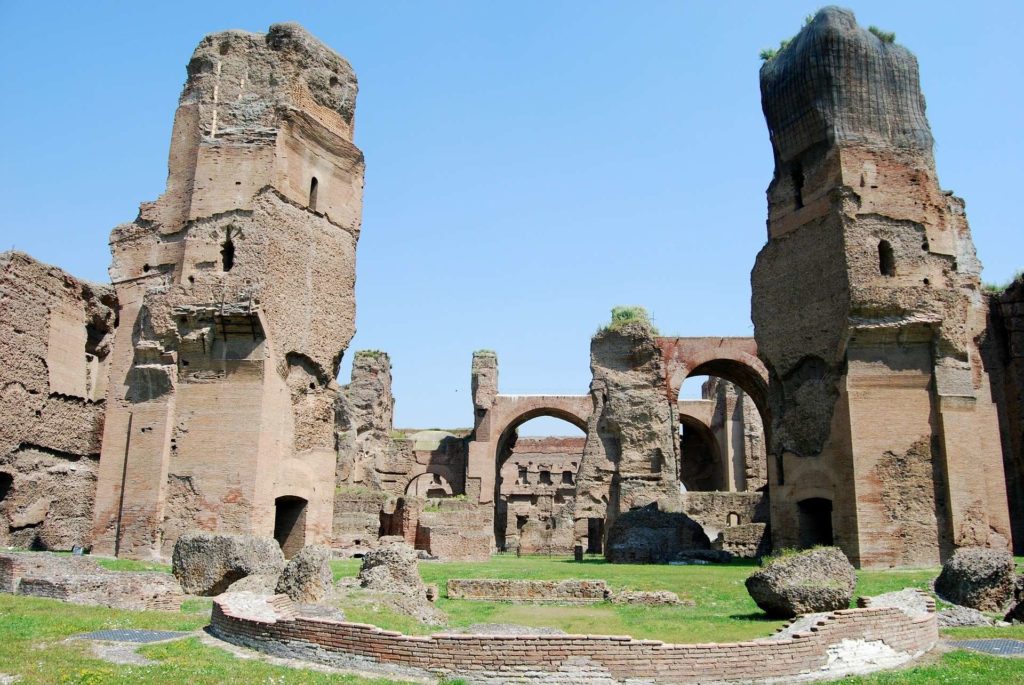
The Baths of Caracalla, or Terme di Caracalla in Italian, are the ruins of a vast ancient Roman public bath complex located in Rome, Italy. Constructed during the reign of Emperor Caracalla (211-217 AD), the baths were one of the largest and most impressive public bathing facilities in the Roman Empire. They were in operation until the 6th century and could accommodate up to 1,600 bathers at a time.
The Baths of Caracalla were not only a place for bathing but also a social and recreational center. The complex included various amenities, such as a gymnasium, libraries, gardens, and spaces for relaxation and entertainment. The baths were an architectural marvel, with impressive vaulted ceilings, intricate mosaics, and colossal marble sculptures.
Today, the ruins of the Baths of Caracalla offer a fascinating insight into the daily life and leisure activities of ancient Romans. Visitors can explore the remains of the various rooms, including the frigidarium (cold room), the tepidarium (warm room), and the caldarium (hot room), as well as the natatio, which was the large open-air swimming pool. The site also features the remnants of the impressive hypocaust system, which was an advanced heating system that circulated hot air beneath the floors and through the walls to maintain the desired temperatures in the various rooms.
The Baths of Caracalla also serve as a unique venue for cultural events, such as opera performances and concerts, which take place during the summer months. The dramatic backdrop of the ancient ruins and the historical significance of the site make these events a truly memorable experience.
Visiting the Baths of Caracalla offers a unique opportunity to appreciate the architectural and engineering achievements of ancient Rome, as well as to imagine the social and cultural atmosphere of the time.
15. San Giovanni in Laterano (Basilica of St. John Lateran)
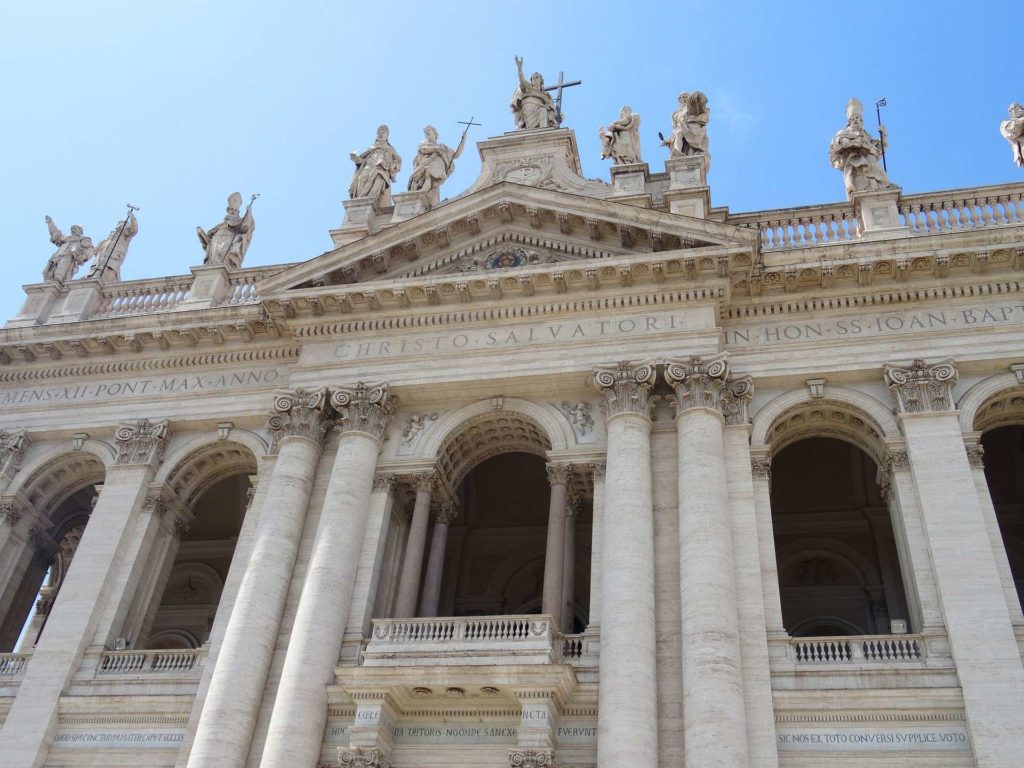
San Giovanni in Laterano, or the Basilica of Saint John Lateran in English, is one of the four major papal basilicas in Rome, Italy. It is also known as the Archbasilica of the Most Holy Savior and Saints John the Baptist and John the Evangelist at the Lateran. As the cathedral of the Bishop of Rome, who is the Pope, San Giovanni in Laterano holds the title of “Mother and Head of all the Churches in the City and the World.”
The basilica has a long and rich history, dating back to the 4th century when Emperor Constantine the Great donated the land for its construction. The basilica has been rebuilt and renovated numerous times due to fires, earthquakes, and other damage, resulting in a mix of architectural styles, including elements from the original early Christian design, as well as later Baroque and Neoclassical additions.
The façade of the basilica features a grand staircase, statues of Christ and the saints, and an inscription indicating its status as the “Mother Church.” The interior of the basilica is adorned with beautiful mosaics, frescoes, and sculptures, including the magnificent 13th-century Cosmatesque floor, the towering baldachin by Giovanni di Stefano, and the 15th-century wooden ceiling.
Adjacent to the basilica is the Lateran Palace, which served as the papal residence for centuries before the popes moved to the Vatican. The palace now houses the Museo Storico Vaticano, or the Vatican Historical Museum, which showcases a collection of artifacts related to the papacy, including vestments, paintings, and historical documents.
The Holy Stairs, or Scala Santa, are another notable feature of the Lateran complex. According to tradition, these 28 marble steps are the same ones that Jesus ascended during his trial before Pontius Pilate, and they were brought to Rome by Saint Helena, the mother of Emperor Constantine. The stairs are now covered in wood to protect them from wear, and pilgrims often ascend them on their knees as an act of devotion.
San Giovanni in Laterano is not only an important religious site but also a significant historical and artistic attraction in Rome. As a symbol of the Pope’s authority as the Bishop of Rome, the basilica holds a unique place in the Catholic Church and offers visitors a glimpse into the rich history and traditions of the papacy.
16. The Catacombs and Via Appia Antica (Appian Way)
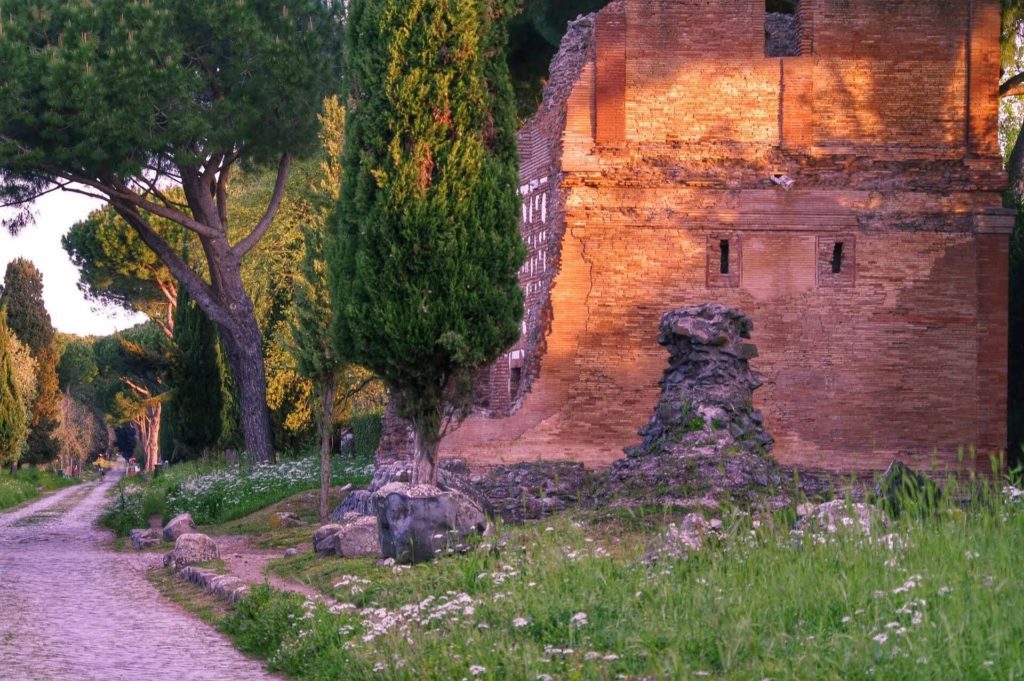 The Catacombs and Via Appia Antica are two historically significant sites in Rome that offer a glimpse into the city’s ancient past.
The Catacombs and Via Appia Antica are two historically significant sites in Rome that offer a glimpse into the city’s ancient past.
Catacombs
The catacombs in Rome are vast underground burial sites that date back to the 2nd century AD. These subterranean passageways, carved out of the soft volcanic rock called tuff, were mainly used by early Christians, Jews, and other religious communities for the interment of their deceased. The most famous catacombs in Rome include the Catacombs of Saint Callixtus, Saint Sebastian, Domitilla, and Priscilla.
The catacombs feature miles of narrow tunnels lined with tombs, as well as chambers containing frescoes, inscriptions, and other artworks that provide valuable insights into the beliefs, customs, and daily lives of the people who created them. Due to their religious significance, the catacombs also served as places of worship and refuge for persecuted Christians during times of persecution.
Visitors to the catacombs can take guided tours to explore these fascinating underground labyrinths, learn about their history, and appreciate the art and architecture of the early Christian communities.
Via Appia Antica
The Via Appia Antica, or Appian Way, is one of the oldest and most important Roman roads. It was built in 312 BC by Appius Claudius Caecus and originally connected Rome to the southern city of Brindisi. Over time, the road was extended and became a vital transportation route for the Roman Empire, facilitating the movement of people, goods, and military forces.
Today, the Via Appia Antica is a protected archaeological site and a popular destination for visitors who want to explore its ancient ruins, monuments, and landscapes. Some notable sites along the Appian Way include the Villa of the Quintilii, the Circus of Maxentius, and the Tomb of Cecilia Metella.
The Via Appia Antica is also a popular area for leisurely walks, bike rides, and picnics, offering a peaceful escape from the hustle and bustle of the city. The road is lined with towering pine trees, ancient milestones, and fragments of the original basalt paving stones, providing a unique and evocative atmosphere for visitors to experience the history of ancient Rome.
Both the catacombs and the Via Appia Antica offer valuable insights into the history, culture, and daily life of ancient Rome, making them essential destinations for anyone interested in exploring the city’s rich past.
17. Terme di Diocleziano (Baths of Diocletian National Museum)
The baths of Diocletian were so vast that they now contain two churches, a large part of the Carthusian monastery and a large museum. The vast tepidarium (hot baths) were used by Michelangelo as the shell for his church of Santa Maria Degli Angeli, and the National Museum of Rome, the Museo Nazionale Romano, fills another section with ancient treasures: Greek and Roman sculpture, pre-Christian and later sarcophagi, and beautiful mosaics and frescoes.
The church of San Bernardo Alle Terme was built at the corner of the baths in a rotunda in the late 16th-century; its dome is like that of the Pantheon, but only half its size.
18. Enjoy a gelato (Italian ice cream)
Gelato, the Italian version of ice cream, is known and loved for its rich, creamy texture and intense flavors. The main difference between gelato and traditional ice cream lies in the ingredients and the production process. Gelato is made with a higher proportion of milk to cream, resulting in a lower fat content. Additionally, it has less air incorporated during the churning process, giving it a denser, smoother consistency.
The use of high-quality, natural ingredients is key to creating the signature flavors of gelato. Fresh fruit, nuts, chocolate, and other flavorings are carefully sourced and combined to create a wide variety of flavors, ranging from classic options like stracciatella (vanilla with chocolate shavings), pistachio, and hazelnut, to more unique and inventive choices such as lavender, rose, and balsamic vinegar.
When in Italy, you can enjoy gelato at a local gelateria, which is a shop specializing in the production and sale of gelato. To ensure you’re getting the best quality, look for a gelateria that makes their gelato on-site using natural ingredients, and avoid those with brightly colored or excessively mounded displays, as these can indicate artificial additives or lower-quality products.
When ordering gelato, you can usually choose between a cone (cono) or a cup (coppa), and you’ll often have the option to select multiple flavors in a single serving. This is a great opportunity to try a variety of flavors and combinations. Gelato is best enjoyed fresh, so take the time to savor it as you stroll through the streets or relax in a picturesque piazza.
Enjoying a gelato in Italy is more than just a treat; it’s a quintessential Italian experience that allows you to indulge in the country’s culinary culture and appreciate the craftsmanship and passion that goes into creating this beloved dessert.
19. Go shopping in Rome
Rome is a city that has so much to offer, from its rich history to its culinary delights. One of the most exciting experiences that Rome has to offer is shopping. Whether you are looking for designer fashion, local crafts, or gourmet food, Rome has it all. The city is filled with bustling markets, trendy boutiques, and luxury department stores that cater to every taste and budget. From the famous Via del Corso to the quaint streets of Trastevere, there is no shortage of places to shop in Rome. So, if you are planning a trip to the Eternal City, be sure to set aside some time for a shopping spree. In this article, we will explore some of the best places to go shopping in Rome and give you some tips on how to get the most out of your shopping experience.
Go shopping in Via del corso
Via del Corso is one of Rome’s most famous and bustling shopping streets, stretching approximately 1.5 kilometers (0.9 miles) from Piazza Venezia to Piazza del Popolo. This long, straight avenue is lined with a mix of international and Italian brands, as well as local boutiques, offering a wide range of shopping options for all budgets and tastes.
When shopping on Via del Corso, you can find everything from affordable high-street fashion stores, such as Zara, H&M, and Mango, to more upscale Italian brands like Max Mara and Liu Jo. Along the way, you’ll also discover numerous shoe stores, leather goods shops, and accessories boutiques, featuring both well-known labels and emerging Italian designers.
In addition to fashion, Via del Corso is home to several bookstores, electronics stores, and souvenir shops, making it a one-stop destination for all your shopping needs. If you’re looking for more high-end designer stores, you can venture into the nearby streets of Via dei Condotti, Via Borgognona, and Via Frattina, which are known for their luxury boutiques.
While shopping on Via del Corso, you can also enjoy the historic and architectural beauty of the surrounding area. The street is bordered by several important landmarks and monuments, including the Piazza Venezia, Piazza del Popolo, and the Spanish Steps. It’s the perfect place to combine your shopping excursion with sightseeing and exploration of Rome’s rich history and culture.
After a long day of shopping, you can relax and refuel at one of the many cafes, restaurants, or gelaterias located along Via del Corso or in the nearby side streets. Here, you can indulge in delicious Italian cuisine, a refreshing drink, or a sweet treat before continuing your Roman adventure.
Shopping in Via del Corso is an enjoyable and quintessential Roman experience that allows you to immerse yourself in the city’s vibrant atmosphere while discovering the latest Italian fashion trends and unique local products.
Go shopping in Via condotti
Via Condotti is one of Rome’s most elegant and upscale shopping streets, located near the Spanish Steps and the Piazza di Spagna. This prestigious shopping district is famous for its luxury boutiques, designer stores, and refined atmosphere, making it an ideal destination for high-end shopping and window browsing.
When shopping on Via Condotti, you’ll find a range of exclusive Italian and international brands, such as Gucci, Prada, Bulgari, Louis Vuitton, Fendi, Dolce & Gabbana, and Valentino, among others. The street is also home to several high-end jewelers, including Cartier, Buccellati, and Bvlgari, which is housed in a stunning palazzo dating back to the 18th century.
In addition to luxury fashion, Via Condotti offers a selection of upscale Italian accessories, leather goods, and specialty stores. One of the most famous establishments on the street is the Antico Caffè Greco, Rome’s oldest and most iconic café, which has been serving customers since 1760. The café has been frequented by numerous artists, writers, and celebrities throughout history and is the perfect place to take a break from shopping and enjoy an espresso, a pastry, or a light meal in a historic and sophisticated setting.
As you stroll along Via Condotti, you’ll also have the opportunity to appreciate the elegant architecture and picturesque streets of the surrounding area. The street is lined with beautifully preserved palazzos, and the nearby Piazza di Spagna and Spanish Steps provide a scenic backdrop for your high-end shopping experience.
While the prices on Via Condotti may be steep, the street offers a unique shopping experience that allows you to indulge in Rome’s luxury fashion scene and immerse yourself in the city’s elegant and exclusive atmosphere. Whether you’re looking to make a lavish purchase or simply enjoy window shopping and people-watching, Via Condotti is a must-visit destination for fashion enthusiasts and admirers of Italian style.
20. Things to do in Rome at night
Rome is a vibrant city that comes alive at night, offering numerous activities and experiences for visitors to enjoy. Here are some suggestions for things to do in Rome after the sun goes down:
- Evening strolls: Rome’s historic center is beautifully illuminated at night, making it the perfect time for a leisurely stroll. Wander around famous landmarks such as the Colosseum, the Roman Forum, the Pantheon, and the Spanish Steps, all of which take on a magical atmosphere in the evening.
- Piazzas and nightlife: Rome’s lively piazzas are bustling with activity at night, with people gathering to socialize, dine, and enjoy street performances. Popular spots include Piazza Navona, Campo de’ Fiori, and Trastevere, where you can find an array of bars, clubs, and restaurants offering a mix of music, dancing, and entertainment.
- Dining and Aperitivo: Rome is known for its delicious cuisine, and there are countless restaurants, trattorias, and pizzerias to choose from. For a more casual pre-dinner experience, try an aperitivo, which is a social tradition of enjoying drinks and small bites at a bar or café before dinner.
- Wine bars and craft beer: Rome’s wine bars, or enoteche, offer a wide selection of Italian wines, often accompanied by cheese and charcuterie boards. If you prefer beer, Rome’s craft beer scene has been steadily growing, with many pubs and bars offering a range of local and international brews.
- Attend an opera, concert, or theater performance: Rome has a rich cultural scene, and you can find various performances to suit your taste, from opera and classical music at the Teatro dell’Opera or Auditorium Parco della Musica, to contemporary theater and live music at smaller venues throughout the city.
- Evening guided tours: Some of Rome’s famous landmarks and museums offer evening tours or extended hours, allowing you to explore these attractions in a unique setting. Options include the Vatican Museums’ Friday night openings, the Colosseum’s night tours, or the occasional special evening events at the Capitoline Museums or Galleria Borghese.
- Outdoor cinema: During the summer months, Rome hosts a variety of outdoor movie screenings in parks, gardens, and other public spaces. It’s a great way to enjoy a film under the stars while soaking up the city’s atmosphere.
- Rome by night bus tour: If you prefer a more structured evening activity, consider joining a Rome by night bus tour. These tours typically take you around the city’s most famous landmarks, which are beautifully lit up at night, providing a different perspective of Rome’s iconic sites.
No matter your interests, Rome offers a diverse range of nighttime activities that cater to a variety of tastes, ensuring an enjoyable and memorable experience in the Eternal City.
FAQs
What is the best time to visit Rome?
The best time to visit Rome is during the spring (April to June) and fall (September to October) when the weather is mild, and the tourist crowds are smaller. Summer (July and August) can be very hot and crowded, while winter (November to February) is cooler and wetter but may offer lower accommodation prices and fewer tourists.
How many days do I need to visit Rome?
It is recommended to spend at least 3-4 days in Rome to explore the city's main attractions and landmarks. However, if you want to explore the city more in-depth or take day trips to nearby destinations, you may want to consider staying for a week or more.
What is the best way to get around Rome?
Rome is a walkable city, and many attractions are within walking distance of each other. For longer distances, the public transportation system, including buses, trams, and metro, is a convenient option. Taxis and rideshare services like Uber are also available.
What are the must-see attractions in Rome?
Some of the must-see attractions in Rome include the Colosseum, Roman Forum, Vatican City, St. Peter's Basilica, Pantheon, Trevi Fountain, Spanish Steps, and Piazza Navona, among others.
Do I need to know Italian to visit Rome?
While it's always helpful to know some basic Italian phrases, most people working in the tourism industry in Rome speak English, and many restaurants and attractions offer information in English. However, learning a few Italian phrases can enhance your experience and help you connect with locals.
What is the currency in Rome?
Rome, as part of Italy, uses the Euro (€) as its currency. It's always a good idea to have some cash on hand, especially for smaller establishments that may not accept credit cards.
Is Rome safe for tourists?
Rome is generally considered safe for tourists. However, like in any major city, it's essential to be aware of your surroundings, especially in crowded areas where pickpocketing can occur. Use common sense, keep your belongings secure, and avoid poorly lit or deserted areas at night.
Can I drink tap water in Rome?
Yes, tap water in Rome is safe to drink. The city is also known for its numerous public drinking fountains, called "nasoni," where you can refill your water bottle with fresh, cold water for free.
What is the tipping culture in Rome?
In Rome, tipping is not obligatory but is appreciated for good service. For restaurants, a tip of around 10% is standard if service is not already included in the bill. For other services like taxis, rounding up to the nearest Euro or adding a small amount is acceptable.





